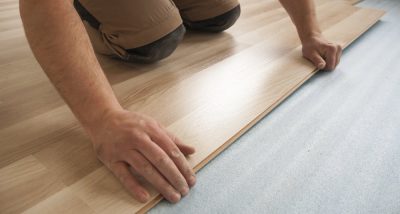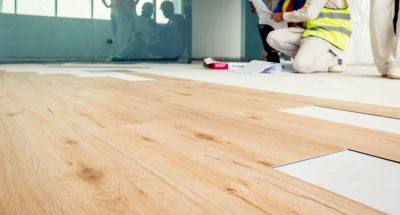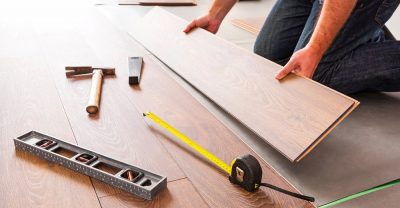- Oneflare /
- Cost Guides /
- Vinyl Flooring

How much does vinyl flooring installation cost in Australia in 2025?
$25 - $55 per m2
How much does vinyl flooring installation cost in Australia?
Affordable vinyl flooring with prices ranging from $25 to $55 per square metre for durable, stylish, and low-maintenance options.
Key Takeaways
|
Vinyl flooring is a modern and effective option that replicates the look of high-end materials like hardwood and stone. It results in an elegant look without the premium price tag. Most vinyl flooring is durable, easy to maintain, and practical for families and busy households.
If you find yourself planning a home remodelling project, consider this guide to explore vinyl flooring installation costs in Australia. Learn a thing or two about selecting the type that best suits your style and preferences to ensure a satisfying and smooth vinyl installation experience.
How much does vinyl flooring installation cost per square metre?
In Australia, vinyl floor installation cost per sqm can vary depending on the type of vinyl, the type of materials used (like hardwood flooring, wood, or stone), and regional labour rates. Despite these factors, they will generally cost the following based on your respective state:
| Disclaimer: These prices are only estimated starting points for budgeting. Actual costs may vary based on specific project requirements and local market conditions. |
| State | Average labour costs |
| New South Wales | $200–$510 |
| Victoria | $160–$550 |
| Queensland | $140–$500 |
| Western Australia | $220–$500 |
| South Australia | $180–$540 |
How much does it cost to have vinyl flooring installed?
Vinyl flooring supply and installation prices are available based on various types, and each comes with unique features, benefits, and cost ranges. Below is a summary of the common types of vinyl flooring, their characteristics, how much flooring cost, and their ideal use cases:
| Type | Material cost | Installation cost | Key features | Best for |
| Sheet vinyl | $25–$45 | $35–$55 | Water resistant, durable | Kitchens and bathrooms |
| Vinyl tiles | $30–$55 | $35–$55 | Easily customisable, easy to replace | Decorative areas and spaces |
| Vinyl planks | $35–$65 | $35–$50 | Hardwood look, premium-looking aesthetic | Living rooms, bedrooms |
| Luxury vinyl | $55–$115 | $40–$55 | High-quality aesthetic, waterproof | High-traffic areas |
What are the different types of vinyl flooring?
Installing luxury vinyl plank flooring. | Source: iStockVinyl flooring comes in various types, offering unique benefits and price points. The cost to install vinyl wood flooring typically depends on the type chosen, with luxury options being higher in price but offering long-term value through durability and aesthetics.
Vinyl sheet
Similar to the cost appeal of laminate flooring, this type of vinyl is a cost-friendly flooring option, since it can be glued down or installed as a loose-lay format. Popular because of its water-resistant properties, vinyl sheet is the best option for bathrooms or kitchens. Although it’s a great option for large spaces, an expert might be needed to achieve a smooth and professional-looking finish.
Vinyl floor tiles
Vinyl floor tiles are designed to look like ceramic or stone, and are very easy to replace when damaged. Their customisable patterns and layouts offer unique design possibilities, and they can be easily replaced when damaged, which adds to their practicality. This makes them particularly suitable for high-traffic or decorative spaces where both durability and aesthetics are key considerations.
Vinyl planks
These long, durable boards offer a realistic wood appearance but with added water resistance, making them perfect for both stylish and functional spaces. With mid-range pricing, vinyl plank flooring installation costs are more affordable for those with a limited budget. They also have a straightforward installation process, with some styles using click-lock systems, helping to reduce labour expenses.
Luxury vinyl
Luxury vinyl can come as tiles or planks and is a higher-end option with great durability and comfort. It resembles the appearance of natural materials like wood or stone, and is completely waterproof, making it ideal for busy areas or elegant spaces. Its thicker design makes it softer and quieter to walk on, while its surface finish protects against scratches and stains, preserving its look for longer.
What are the factors that influence vinyl flooring prices?
Multiple factors affect the cost of laying vinyl flooring, from materials to the overall complexity of the project.
Type of vinyl flooring
One thing homeowners should consider is what type of vinyl flooring they want for their space. Luxury vinyl, for instance, tends to be more expensive than other types because of its enhanced durability and realistic textures. On the other hand, sheet vinyl is a more affordable option and is best for spaces like kitchens and bathrooms where moisture resistance is a priority.
Subfloor conditions
Uneven or damaged subfloors can require more preparation for a smoother and more durable installation. While this step can lead to higher costs, especially for older homes with pre-existing issues, proper preparation prevents issues like uneven surfaces or peeling over time.
State and location
The cost to install vinyl flooring varies between Australian cities. Metropolitan cities and CBDs, like Sydney or Melbourne, generally have higher fees, with entry prices ranging from $160 to $200 due to the higher living and labour costs in these regions. In contrast, states like Queensland typically have lower starting rates, with prices beginning around $160.
Conversely, regional cities and rural areas often have lower labour costs, although the availability of skilled installers may be limited, potentially impacting scheduling and project timelines.
Design complexity
Custom patterns or complicated layouts, as well as working on tricky spaces, can require more time, materials, and expertise to install, driving up the overall cost of the project. Homeowners looking to save on costs can consider opting for simpler designs, which typically require less time and effort to install and complete.
Additional services
Services outside the standard installation process, such as removing existing flooring, old tiles, or carpet, or installing underfloor heating and insulation, come at extra costs. These tasks are often necessary to prepare the surface for vinyl flooring, but are typically charged as extra.
For example, removing old carpet or tiles can cost between $10 and $20 per square meter, depending on the flooring material and its attachment to the subfloor. If the existing flooring has been glued down or is in poor condition, the cost may increase due to the additional time and effort required.
Is it better to DIY vinyl flooring installation or hire a professional?
While you can install vinyl flooring yourself, it’s important to weigh the benefits and challenges of DIY versus having the project handled by a professional.
If you’re looking to stick with a home renovation budget, DIY installation can cut costs, especially for easy-to-fit options like click-lock vinyl planks. It does require careful preparation, including subfloor cleaning, levelling, and precise measuring and cutting. In addition, DIY mistakes can lead to uneven surfaces or poorly fitted pieces, which may require costly fixes down the line.
On the other hand, professional installation guarantees a nearly flawless finish, especially for hard or complex projects like sheet vinyl or custom vinyl tile installation. These experts are equipped to handle challenges like intricate cuts or uneven subfloor issues. Although it involves a higher upfront cost, professional installation often delivers better long-term value by ensuring durability and an aesthetically pleasing result.
Reducing your vinyl flooring installation cost
You might be sceptical about hiring local vinyl floor installers instead of doing the work yourself. However, there are ways to keep costs down and achieve professional results.
Ask if you can aid in removing any subfloor or carpeting
Find out if the installer can recommend a reliable vinyl flooring supply shop they have worked for. Using your own materials could reduce the cost of installing vinyl flooring.
Find the perfect floor fit today
The cost to get vinyl flooring installed entails balancing factors like type, cost, and installation needs. From affordable sheet vinyl to premium luxury vinyl, each option has unique benefits suited to different spaces and budgets.
While it’s fine to do the project yourself, it’s often better to leave this complex job to the pros. Hiring a local vinyl flooring installer can get you great value without sacrificing quality. With careful planning, vinyl flooring can transform your space with style and practicality.





